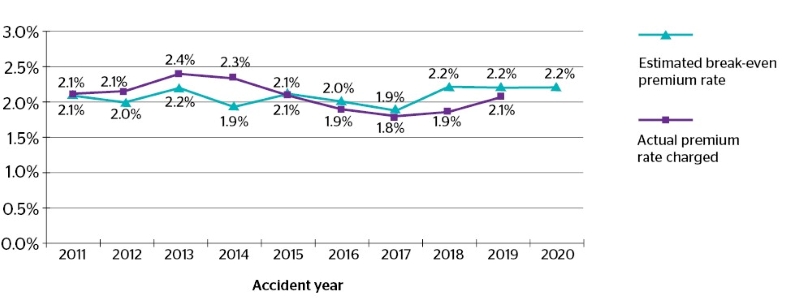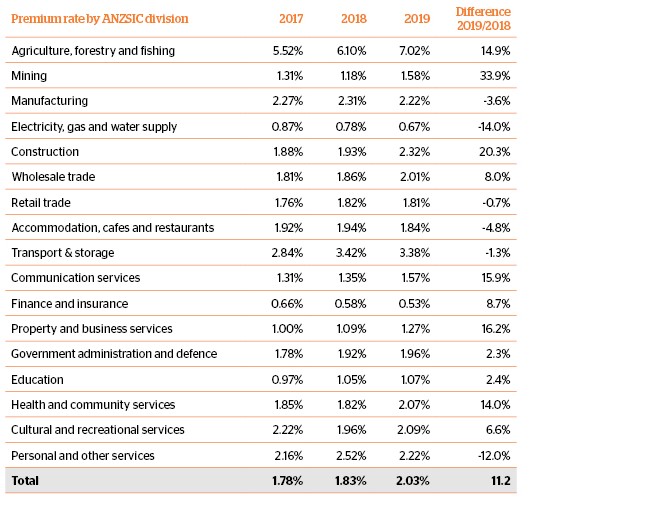
WorkSafe recently released its Actuarial Review of the NT Workers Compensation Scheme - June 2019 report (the Report).
The Report analyses Northern Territory (NT) Workers Compensation scheme (the Scheme) performance and the environment it’s operating in, helping the industry and government set premiums and manage risks.
To help our partners and customers understand the review and what it means to them, we’ve summarised important information including:
- Scheme performance and premium rates
- Claims experience and trends
- Economic environment and other influencing factors.
Key findings and recommendations
- The Report shows the 2019 premium rate remained fairly consistent with previous years but included a marginal increase to address insurer losses and support scheme viability.
- The Report recommended a 2019 - 2020 break-even premium rate (premium needed to cover costs and claims) of 2.2% of wages.
- The Report’s projected 2019-2020 break-even premium rate is the same as 2018-2019, however actual rates are influenced by a number of variable factors.
- Claims numbers show a general decline, however large claims are trending upwards and have had a significant impact on costs.
- Economic factors, in particular the wind-down of the Inpex LNG project, had a direct impact on wages.
- The economic environment including impact of COVID-19 will influence the Scheme and key premium drivers including wages, claims and return to work rates.
Scheme performance and premium rates
Premium performance and funding ratio in 2019
The Report shows premium rate was stable in 2019, remaining fairly consistent with rates over the last five years.
However, the Report showed a gap between break-even premium rates and actual premium rates in recent years and estimated a financial loss for insurers for four of the last five years.
Insurer response to this meant most customers saw modest premium increases in 2019, which have supported continued scheme viability for both customers and insurers.
Notably, premium rates were also driven by the type of industry insured and the risk profiles of those industries. Both mining and construction (both high risk industries) had the largest rate increases in 2019.
Importantly, actual premiums charged could have been driven by changes in the underwriting or economic cycle and were based on more detailed data on claims, costs and risks from individual insurers.
The overall increase in charged premium saw the funding ratio increase to 107% in 2019, up from 102% in 2018.
Actual premium vs estimated break-even premium rate

Source: NT WorkSafe Actuarial Review of the NT Workers Compensation Scheme - June 2019, 2020
Historical rates by industry on an underwriting year basis

Source: NT WorkSafe Actuarial Review of the NT Workers Compensation Scheme - June 2019, 2020
Projected premium
The Report recommended a 2019 - 2020 break-even premium rate of 2.2% of wages with no change from the 2019 estimate to inform actual premium rates.
Importantly, this recommendation is based on assumptions about a number of uncertain and variable factors including economic climate.
It’s also important to understand that this recommended break-even rate isn’t the only driver of the actual premiums charged. As mentioned, industry risk factors and economic activity, as well as insurer data and objectives will also drive premiums and impact 2020 and future rates.
Claims experience and trends
The Report shows the number of claims in the NT have decreased over the last year, but the size and cost of claims grew in 2018 and 2019 when compared to all other accident years since 2011.
Because the Scheme is smaller in size and large settlements are more common in the NT – large claims have had a high impact on the Scheme and the break-even premium. This has also meant gross loss ratio (total incurred losses divided by the total actual premiums) is notably higher than all previous years (except 2018) at 86%.
Notably, the mix of payment types across the accident years has remained stable. Redemptions and non-economic lump sums and weekly benefits are the two largest payment types. These were likely driven by lower employment and return to work rates.

Source: NT WorkSafe Actuarial Review of the NT Workers Compensation Scheme - June 2019, 2020
Economic environment and other influencing factors
Inpex project
In recent years, wages and premiums pools in NT have been driven up by jobs created by the LNG Inpex project. The winding down of the project in 2018 meant the number of workers has reduced significantly in 2019 and total wages have decreased by 15%.
As a result, the Report shows the premium pool has decreased by 6% and may further decrease in in 2020 and future years. Return to work rates are also likely to be impacted and ultimately effect premium rates – particularly for construction businesses.
Economic impact and COVID-19
Economic activity and employment rates have a direct impact on the Scheme’s performance, impacting return to work rates, wages and therefore premium pools and claims.
The COVID-19 pandemic has caused significant uncertainty around Australia’s economic future and the Report noted these uncertainties had not been considered in projections.
However, the Report cited the 2019/20 NT midyear report’s predicted soft short-term economic conditions and acknowledged alongside the more recent uncertainty, there may be more wage decreases and therefore smaller premiums pools across industries.
For more information specific to COVID-19 and its impact to Workers Compensation in NT from NT WorkSafe please visit their COVID-19 information page.
Find out more
Read the full Report or visit the WorkSafe NT website to find out more about Workers Compensation in the NT.
For more information on our Workers Compensation offering, or a personalised analysis of what the Report findings or recent changes might mean for your business, please get in touch with your QBE Business Relationship Manager or broker.
Download a pdf version of this guide
Please note this is a summary of selected information only. The full NT WorkSafe Actuarial Review of the NT Workers Compensation Scheme - June 2019 report should be read to understand findings, projections and data in full context.
The advice in this article is general in nature and has been prepared without taking into account your objectives, financial situation or needs. You must decide whether or not it is appropriate, in light of your own circumstances, to act on this advice.
